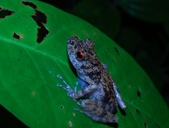|
Description
M 22-24 mm, F 24-27 mm. Dorsum moderately granular, head less broad than in other members of the subgenus Laurentomantis. Ventrally grey without red colour. A yellow vertebral stripe on the posterior dorsum. No tibial gland (Glaw and Vences 2007).
Distribution and Habitat
Country distribution from AmphibiaWeb's database: Madagascar
Ilampy, Marojejy, Masoala, Tsararano (Glaw and Vences 2007). It occurs between 400-800 m asl in pristine rainforest, often but not always close to small streams (Stuart et al. 2008).
Life History, Abundance, Activity, and Special Behaviors
Habits: Males call at night in rainforest from perches 5-50 cm above the ground, often close to streams (Glaw and Vences 2007).
Calls: Unharmonious notes, each consisting of 15-39 widely spaced pulses (Glaw and Vences 2007).
Trends and Threats
Vulnerable; this species is considered abundant but decreasing. It is found in two protected areas: Parc National de Marojejy and Parc National de Masoala. It requires pristine rainforest. The main threat is habitat loss due to subsistence agriculture and grazing, logging, charcoal manufacture, invasion and spread of eucalyptus, and expanding human settlement (Stuart et al. 2008). Possible reasons for amphibian decline General habitat alteration and loss
Habitat modification from deforestation, or logging related activities
Intensified agriculture or grazing
Comments
Taken with permission from Glaw and Vences (2007) and Stuart et al. (2008).
References
Glaw, F., and Vences, M. (2007). Field Guide to the Amphibians and Reptiles of Madagascar. Third Edition. Vences and Glaw Verlag, Köln.
Stuart, S., Hoffmann, M., Chanson, J., Cox, N., Berridge, R., Ramani, P., Young, B. (eds) (2008). Threatened Amphibians of the World. Lynx Edicions, IUCN, and Conservation International, Barcelona, Spain; Gland, Switzerland; and Arlington, Virginia, USA.
Originally submitted by: Miguel Vences and Frank Glaw (first posted 2009-03-31)
Edited by: Kellie Whittaker (2009-04-07)Species Account Citation: AmphibiaWeb 2009 Gephyromantis striatus <https://amphibiaweb.org/species/6025> University of California, Berkeley, CA, USA. Accessed Jun 6, 2025.
Feedback or comments about this page.
Citation: AmphibiaWeb. 2025. <https://amphibiaweb.org> University of California, Berkeley, CA, USA. Accessed 6 Jun 2025.
AmphibiaWeb's policy on data use.
|
